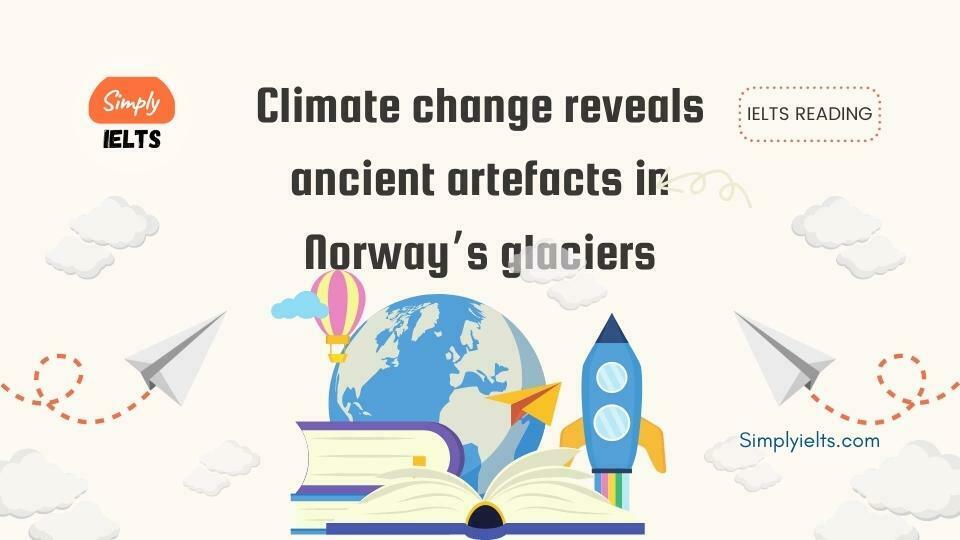Climate change reveals ancient artefacts in Norway’s glaciers IELTS reading test with answers and explanation
A new IELTS Reading Academic test passage 2 from Cambridge IELTS 16 Reading test 3 Climate change reveals ancient artefacts in Norway’s glaciers IELTS reading test with answers and location
In this IELTS Reading exam, you will find Climate change reveals ancient artefacts in Norway’s glaciers IELTS reading test answers with location and explanation

In the answers tab, you can find Climate change reveals ancient artefacts in Norway’s glaciers IELTS reading answers with location
Climate change reveals ancient artefacts in Norway’s glaciers IELTS reading test answers and explanation
READING PASSAGE 2
You should spend about 20 minutes on Questions 14-26 which are based on Reading Passage 2 below.
Climate change reveals ancient artefacts in Norway’s glaciers
A
Well above the treeline in Norway’s highest mountains, ancient fields of ice are shrinking as Earth’s climate warms. As the ice has vanished, it has been giving up the treasures it has preserved in cold storage for the last 6,000 years – items such as ancient arrows and skis from Viking Age* traders. And those artefacts have provided archaeologists with some surprising insights into how ancient Norwegians made their livings
B
Organic materials like textiles and hides are relatively rare finds at archaeological sites. This is because unless they’re protected from the microorganisms that cause decay, they tend no to last long. Extreme cold is one reliable way to keep artefacts relatively fresh for a few thousand years, but once thawed out, these materials experience degradation relatively swiftly.
With climate change shrinking ice cover around the world, glacial archaeologists need to race the clock to find newly revealed artefacts, preserve them, and study them. If something fragile dries and is windblown it might very soon be lost to science, or an arrow might be exposed and then covered again by the next snow and remain well-preserved. The unpredictability means that glacial archaeologists have to be systematic in their approach to fieldwork.
C
Over a nine-year period, a team of archaeologists, which included Lars Pilø of Oppland County Council, Norway, and James Barrett of the McDonald Institute for Archaeological Research, surveyed patches of ice in Oppland, an area of south-central Norway that is home to some of the country’s highest mountains. Reindeer once congregated on these ice patches in the later summer months to escape biting insects, and from the late Stone Age**, hunters followed. In addition, trade routes threaded through the mountain passes of Oppland, linking settlements in Norway to the rest of Europe.
The slow but steady movement of glaciers tends to destroy anything at their bases, so the team focused on stationary patches of ice, mostly above 1,400 metres. That ice is found amid fields of frost-weathered boulders, fallen rocks, and exposed bedrock that for nine months of the year is buried beneath snow.
‘Fieldwork is hard work – hiking with all our equipment, often camping on permafrost – but very rewarding. You’re rescuing the archaeology, bringing the melting ice to wider attention, discovering a unique environmental history and really connecting with the natural environment,’ says Barrett.
D
At the edges of the contracting ice patches, archaeologists found more than 2,000 artefacts, which formed a material record that ran from 4,000 BCE to the beginnings of the Renaissance in the 14th century. Many of the artefacts are associated with hunting. Hunters would have easily misplaced arrows and they often discarded broken bows rather than take them all the way home. Other items could have been used by hunters traversing the high mountain passes of Oppland: all-purpose items like tools, skis, and horse tack.
E
Barrett’s team radiocarbon-dated 153 of the artefacts and compared those dates to the timing of major environmental changes in the region – such as periods of cooling or warming – and major social and economic shifts – such as the growth of farming settlements and the spread of international trade networks leading up to the Viking Age. They found that some periods had produced lots of artefacts, which indicates that people had been pretty active in the mountains during those times. But there were few or no signs of activity during other periods.
F
What was surprising, according to Barrett, was the timing of these periods. Oppland’s mountains present daunting terrain and in periods of extreme cold, glaciers could block the higher mountain passes and make travel in the upper reaches of the mountains extremely difficult. Archaeologists assumed people would stick to lower elevations during a time like the Late Antique Little Ice Age, a short period of deeper-than-usual cold from about 536-600 CE. But it turned out that hunters kept regularly venturing into the mountains even when the climate turned cold, based on the amount of stuff they had apparently dropped there.
‘Remarkably, though, the finds from the ice may have continued through this period, perhaps suggesting that the importance of mountain hunting increased to supplement failing agricultural harvests in times of low temperatures,’ says Barrett. A colder turn in the Scandinavian climate would likely have meant widespread crop failures, so more people would have depended on hunting to make up for those losses.
G
Many of the artefacts Barrett’s team recovered date from the beginning of the Viking Age, the 700s through to the 900s CE. Trade networks connecting Scandinavia with Europe and the Middle East were expanding around this time. Although we usually think of ships when we think of Scandinavian expansion, these recent discoveries show that plenty of goods travelled on overland routes, like the mountain passes of Oppland. And growing Norwegian towns, along with export markets, would have created a booming demand for hides to fight off the cold, as well as antlers to make useful things like combs. Business must have been good for hunters.
H
Norway’s mountains are probably still hiding a lot of history – and prehistory – in remote ice patches. When Barrett’s team looked at the dates for their sample of 153 artefacts, they noticed a gap with almost no artefacts from about 3,800 to 2,200 BCE. In fact, archaeological finds from that period are rare all over Norway. The researchers say that could be because many of those artefacts have already disintegrated or are still frozen in the ice. That means archaeologists could be extracting some of those artefacts from retreating ice in years to come.
—————
*Viking Age: a period of European history from around 700 CE to around 1050 CE when Scandinavian Vikings migrated throughout Europe by means of trade and warfare
**The Stone Age: a period in early history that began about 3.4 million years ago
Now start to answer “Climate change reveals ancient artefacts in Norway’s glaciers IELTS reading test” questions. You will have 20 minutes to answer questions 14 to 26.
.You can download answers as a pdf file from here:
Related articles:
- Describe a puzzle you have played IELTS Cue Card
- A step by step guide to IELTS Speaking Part 2 or cue card
- Describe your favorite movie IELTS Cue Card
- Describe a famous athlete you know IELTS Cue Card
Climate change reveals ancient artefacts in Norway’s glaciers IELTS reading test Questions
click Finish exam to check the correct answers
Climate change reveals ancient artefacts in Norway’s glaciers IELTS Reading Answers
| Questions | Answers |
|---|---|
| 14 | D |
| 15 | C |
| 16 | F |
| 17 | H |
| 18 | G |
| 19 | B |
| 20 | microorganisms / micro-organisms |
| 21 | reindeer |
| 22 | insects |
| 23 | B, C |
| 24 | B, C |
| 25 | A, C |
| 26 | A, C |





Responses